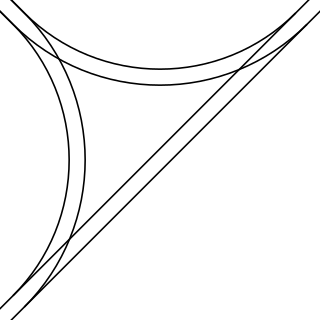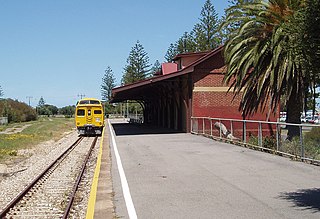
In railroad structures and rail terminology, a wye or triangular junction is a triangular joining arrangement of three rail lines with a railroad switch at each corner connecting to the incoming lines. A turning wye is a specific case.

Woodville railway station is the junction station for the Grange, Outer Harbor and Port Dock lines with the lines diverging immediately north of the station. Situated in the western Adelaide suburb of Woodville, it is 7.5 kilometres from Adelaide station. It has auto pedestrian gates and lights. Platform 3 had a small kiosk, built around 2006, that sells refreshments and tickets, but has not been opened since 2009.

The Adelaide rail network is a metropolitan suburban rail system serving the city of Adelaide, South Australia, Australia. It consists of 89 railway stations across 7 lines, which served a patronage of 15.6 million people over the year 2018-19. Keolis Downer under contract from the Government of South Australia operates the Adelaide suburban rail system. The operations are set to be handed back to the hands of the public by January 2025.

Newton Abbot railway station serves the market town of Newton Abbot in Devon, England. It is 214 miles 5 chains (345 km) from London Paddington. The station today is managed by Great Western Railway, who provide train services along with CrossCountry.

The Dry Creek–Port Adelaide railway line is an eight-kilometre east–west freight railway line running through Adelaide's north-western suburbs. The line is managed by the Australian Rail Track Corporation (ARTC) and is an important link between Port Adelaide, Pelican Point and the main interstate rail routes which link Adelaide with Melbourne, Perth, Darwin and Sydney. Prior to 1988, a limited local passenger service operated, stopping at five intermediate stations along the line. Since May 1988, the line has been freight-only.

Outer Harbor railway station is the terminus station of the Outer Harbor line. Situated in the north-western Adelaide suburb of North Haven, it is 21.9 kilometres from Adelaide station.

Drem railway station serves the small village of Drem in East Lothian, 5 miles (8 km) from the seaside town of North Berwick in Scotland. It is located on the East Coast Main Line (ECML) 18 miles (29 km) east of Edinburgh Waverley. Passenger services are provided on the ScotRail North Berwick Line, and the junction where the North Berwick branch diverges from the ECML is a short distance to the east of the station.
Edinburgh is an outer northern suburb of Adelaide, South Australia in the City of Salisbury. The suburb was created in 1997, on land straddling Penfield and Salisbury, that was compulsorily acquired by the Commonwealth Government in 1940 in order to manufacture munitions for the war effort during World War II, and later used for a number of defence-related establishments.

The State Transport Authority (STA) was the government agency which controlled public transport in South Australia between 1974 and 1994.

Salisbury railway station is a railway station and bus interchange in the northern Adelaide suburb of Salisbury. It is on the Gawler line, 20.2 kilometres (12.6 mi) from Adelaide station. Adjoining it is a large park & ride carpark, making it one of the busiest stations on the Adelaide suburban rail system.
Hilra railway station is a former railway station on the defunct Penfield line which is located in the northern Adelaide suburb of Salisbury North. It is located 21.7 kilometres from the Adelaide station. The station was located parallel to Langford Terrace, adjacent to the freight train line, and inline roughly to Compton Street.

Penfield 3 railway station was located on the Penfield line 25.8 kilometres from Adelaide station in the northern Adelaide suburb which is now called Edinburgh. It was built to service the Salisbury Explosives Factory, built between November 1940 and November 1941.
The Wilts, Somerset and Weymouth Railway (WS&WR) was an early railway company in south-western England. It obtained Parliamentary powers in 1845 to build a railway from near Chippenham in Wiltshire, southward to Salisbury and Weymouth in Dorset. It opened the first part of the network but found it impossible to raise further money and sold its line to the Great Western Railway (GWR) in 1850.
The Adelaide–Port Augusta railway line is the main route for northbound rail traffic out of Adelaide, South Australia. The line, 315 kilometres long, is part of the Adelaide–Darwin rail corridor and the Sydney–Perth rail corridor.
The Salisbury branch line of the Great Western Railway from Westbury to Salisbury in Wiltshire, England, was completed in 1856. Most of the smaller stations were closed in 1955 but the line remains in use as part of the Wessex Main Line.

Chard Junction railway station was situated on the London and South Western Railway’s West of England Main Line about 1 mile (1.6 km) southeast of the village of Tatworth in Somerset, England. It was the junction of a short branch line to Chard. It was opened in 1860 as Chard Road, and closed in 1966. An adjacent milk depot was served by its own sidings from 1937 to 1980. Chard Junction signal box remained open to control Station Road level crossing and a passing loop on the long section of single track railway between Yeovil Junction and Pinhoe until March 2021, when control was passed to Basingstoke.
The Cambridge Branch is a rural railway line in the Waikato, New Zealand. The line stretches from Ruakura Junction for 15.08 kilometres (9.37 mi) to the settlement of Hautapu, having previously continued another 4.19 kilometres (2.60 mi) to the township of Cambridge. It had five stations along its length, at Newstead, Matangi (Tamahere), Bruntwood (Fencourt), Hautapu and the terminus at Cambridge.
Penfield is a northern suburb of Adelaide, South Australia, in the City of Playford.
Hendon railway station was the only station on the Hendon branch line in the western Adelaide suburb of Hendon. Used mainly for industrial purposes in the mid-20th century, the line diverged from Albert Park station and ran for 1.1 kilometres.











